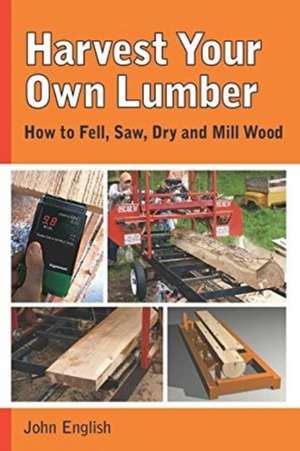Harvest Your Own Lumber
Autor John English.en Limba Engleză Paperback – 31 ian 2015
Preț: 122.91 lei
Preț vechi: 134.23 lei
-8% Nou
Puncte Express: 184
Preț estimativ în valută:
23.52€ • 24.47$ • 19.42£
23.52€ • 24.47$ • 19.42£
Carte indisponibilă temporar
Doresc să fiu notificat când acest titlu va fi disponibil:
Se trimite...
Preluare comenzi: 021 569.72.76
Specificații
ISBN-13: 9781610352437
ISBN-10: 1610352432
Pagini: 140
Ilustrații: 250 colour photos
Dimensiuni: 155 x 230 x 8 mm
Greutate: 0.27 kg
Editura: Linden Publishing
Colecția Linden Publishing
ISBN-10: 1610352432
Pagini: 140
Ilustrații: 250 colour photos
Dimensiuni: 155 x 230 x 8 mm
Greutate: 0.27 kg
Editura: Linden Publishing
Colecția Linden Publishing
Recenzii
"Well organized and written ... explains all the steps involved in lumber harvesting with clarity and a dash of humour." Carl Duguay, Canadian Woodworking & Home Improvement Magazine
Cuprins
Table of Contents
Harvest Your Own Lumber
Introduction
Section 1: All About Wood
. Hardwoods and Softwoods
. Choosing a Species to Harvest
. Density
. Grain Pattern and Defect
. Anatomy of a Tree
. Choosing a Cut
. Know Your Grade
. Dimensions
Section 2: Chainsaws
. Where to Buy
. Choosing a Chainsaw
. Terminology
. Safety
. Sharpening
Section 3: Felling
. Cut the Notch
. Removfing the Main Trunk
. Problems
. Limbing and Bucking
. Moving Logs Around
. Wedges
Section 4: Sawing
. Types of Sawmills
. Portable Band Mills
. How a Band Saw Mill Works
. Commercial Mills
. Sawing Choices
. Measurement
. Board Feet
. Random Sizing
. Color and Grain
. NHLA Hardwood Lumber Grades
. Sawing for Veneer
Section 5: Drying
. Why Dry
. Types of Humidity
. Air Drying
. Moisture Meters
. Gas and Electric Kilns
. Solar Kilns
Section 6: Milling
. Dressing Jointer and Planer
. Milling Terms
. Defects
. Avoiding Planer Snipe
Harvest Your Own Lumber
Introduction
Section 1: All About Wood
. Hardwoods and Softwoods
. Choosing a Species to Harvest
. Density
. Grain Pattern and Defect
. Anatomy of a Tree
. Choosing a Cut
. Know Your Grade
. Dimensions
Section 2: Chainsaws
. Where to Buy
. Choosing a Chainsaw
. Terminology
. Safety
. Sharpening
Section 3: Felling
. Cut the Notch
. Removfing the Main Trunk
. Problems
. Limbing and Bucking
. Moving Logs Around
. Wedges
Section 4: Sawing
. Types of Sawmills
. Portable Band Mills
. How a Band Saw Mill Works
. Commercial Mills
. Sawing Choices
. Measurement
. Board Feet
. Random Sizing
. Color and Grain
. NHLA Hardwood Lumber Grades
. Sawing for Veneer
Section 5: Drying
. Why Dry
. Types of Humidity
. Air Drying
. Moisture Meters
. Gas and Electric Kilns
. Solar Kilns
Section 6: Milling
. Dressing Jointer and Planer
. Milling Terms
. Defects
. Avoiding Planer Snipe
